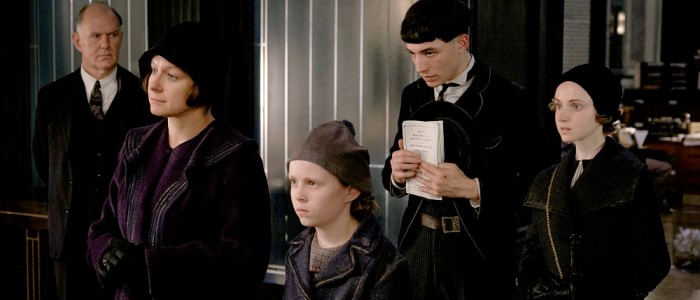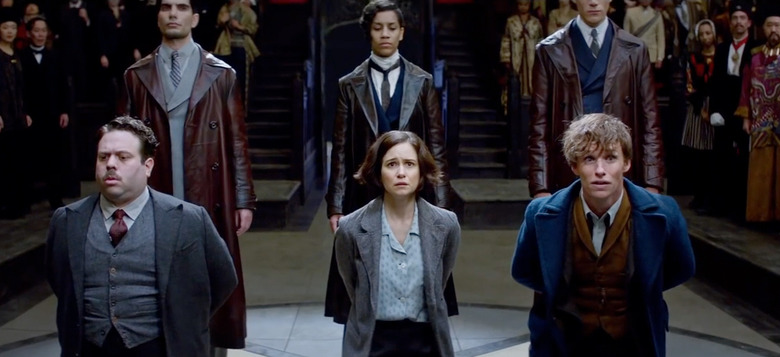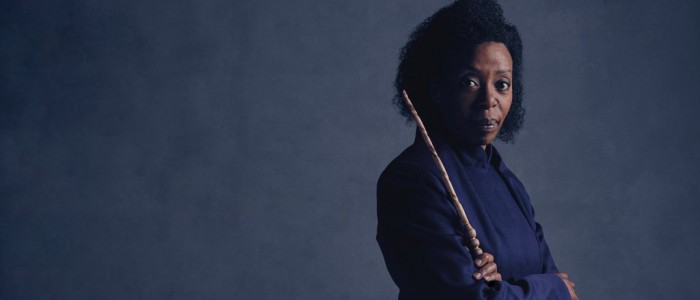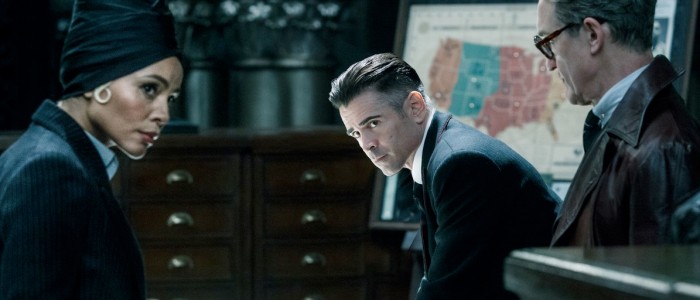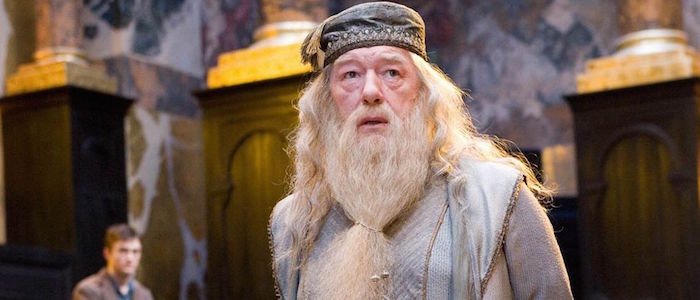It's Time For 'Fantastic Beasts' And The Harry Potter Universe To Become More Inclusive
Like Harry Potter, Fantastic Beasts and Where to Find Them is a fantastical adventure grounded in real-world themes of prejudice and acceptance. Like Harry Potter, Fantastic Beasts and Where to Find Them uses a powerful dark wizard to stand in for the tyrants and hatemongers who've rained down terror on minorities throughout history. Like Harry Potter, Fantastic Beasts and Where to Find Them hinges on a group of more open-minded heroes, some of whom belong to those metaphorically marginalized groups themselves.
And also like Harry Potter, Fantastic Beasts and Where to Find Them does all this with few actually oppressed minorities in sight. It's time for the Potterverse to open up and become more inclusive. (Spoilers ahead for Fantastic Beasts.)
Fantastic Beasts Is a Metaphor for Oppression
Fantastic Beasts borrows heavily from modern history, particularly when it comes to race and intolerance. Grindelwald promotes wizard supremacy as being "for the greater good," arguing that Muggles and other races would be better off under the rule of their magical superiors. While not all wizards subscribe to his ideology, there's clearly some everyday tension between the magical and non-magical communities in America, with Grindelwald's followers eager to incite a race war and the No-Maj Second Salemers equally determined to stamp out the wizards. At one point, Newt and Tina have a conversation about, basically, wizard miscegenation, with Newt sniffing that MACUSA's laws about wizard/No-Maj relationships seem "a bit backwards."
The film leans heavily on recognizable LGBTQ themes as well. Credence is born with magical powers, but belongs to a family of anti-magic fanatics. He's spent most of his life trying to repress his abilities, which has made him very scared, very angry, and very dangerous. Graves essentially seduces Credence into working with him, making the younger man feel special instead of freakish and comforting him with false promises of happiness and glory. Their scenes together are riveting but also deeply uncomfortable, shot through as they are with an almost sexual tension. (As Jackson Bird notes in this video at ScreenCrush, it brings to mind "very old and very dangerous stereotypes of gay people" as child predators.)
While the parallels aren't quite perfect, they're unmistakable and impossible to ignore. But again, everyone involved appears to be straight and white. The only notable characters of color in Fantastic Beasts are MACUSA president Seraphina Picquery (played by black actress Carmen Ejogo), who plays a very minor role in the adventure; and Newt's old friend Leta Lestrange (played by black actress Zoë Kravitz), who is only seen in a photograph. Nor is there any suggestion that the main characters are anything other than cisgender and heterosexual. Newt and Jacob have opposite-sex love interests in the form of Tina and Queenie; if any of them are bisexual, there is no hint of it in the movie. And for all the weird subtext between them, Grindelwald and Credence's sexualities don't really come up.
... But It Excludes Oppressed People From the Narrative
To be sure, the Potterverse treats most of these Muggle divisions very gingerly. As far as we can tell in Fantastic Beasts and Harry Potter, wizards don't seem to care at all about skin color. Heck, Fantastic Beasts casually shows a black female MACUSA president nearly a century before we No-Majs elected Barack Obama. The racial divide in the wizarding community seems to have more to do with the "purity" of one's bloodline than nationality or ethnicity. It's tougher to say how wizards feel about LGBTQ characters, since there really aren't any — aside from Dumbledore, that is, who was only revealed as gay after all the books had already been published, and who is referenced but never appears in Fantastic Beasts.
But the Potterverse is being created and consumed by people who exist in a reality where things like race and sexuality matter a great deal. We understand Grindelwald and Voldemort as stand-ins for genocidal rulers like Hitler, and the experiences of their victims as references to the trials that we, our loved ones, and our ancestors have suffered. We process Credence's journey as that of a closeted young man's, and relate to his pain and fury on that level. And yet, non-white, non-straight people are essentially invisible in the Potterverse. By centering metaphors for POC and LGBTQ struggle on straight white characters, the Potterverse is erasing POC and LGBTQ people from our own narratives.
It's a baffling and frustrating omission. Here is a franchise that purports to be all about tolerance and acceptance, but struggles to extend its empathy toward metaphorically repressed people to actually repressed people. Even in this anything-goes fantasy universe, populated by Nifflers and Bowtruckles, Legilimens and Aurors, it's apparently asking too much to imagine lesbian witches or Latino wizards. It's nice that the Potterverse preaches tolerance and denounces bigotry. But without any significant LGBTQ or POC characters to empathize with, those themes are purely theoretical. Bringing in LGBTQ and POC characters would allow the franchise's warm and fuzzy message to hit that much harder.
The Potterverse Should Know Better
What's especially galling is that the Potter team is clearly aware of the significance an LGBTQ or POC hero would have for the fanbase. When Rowling revealed during a public appearance that Dumbledore was gay, the response was so enthusiastic that she added, "I would have told you earlier if I knew it would make you so happy." Similarly, the Potter franchise surprised fans by announcing a black actress as Hermione in Harry Potter and the Cursed Child, again to a largely positive reception. When a handful of fans protested, Rowling pointed out that "white skin was never specified" in Hermione's description in the novels, and Rowling's more tolerant fans showered her with praise. Imagine how the franchise's non-white, non-straight fans would have responded to seeing someone like themselves battling Grindelwald in Fantastic Beasts.
But in those cases, the stakes were somewhat lower. By the time Rowling dropped that Dumbledore bombshell, all the books had already been published (with nary a mention of Dumbledore's sexuality in any of their pages), and the film series was already well underway (with no mention of Dumbledore's sexuality there, either). There was no real danger that the franchise would alienate fans over that reveal. The casting of Noma Dumezweni as Hermione in Cursed Child was a bit bolder, but most fans will still think of Hermione as white because that's the way she was portrayed in the movies. We don't know why the Potterverse makes the decisions that it does, and we don't claim to. But it seems telling that they've proven more willing to embrace inclusivity when the risks are very low.
Fantastic Beasts Was a Missed Opportunity
One could argue that the core Harry Potter series, which put out books and movies through the 1990s and 2000s, was a product of a time when audiences were less tolerant or less aware, and artists were more oblivious. But Fantastic Beasts doesn't have that excuse. This was a chance for the Potterverse to start fresh, and build a more diverse cast of characters from the ground up. The architects behind this universe clearly understand that the world has changed, as evidenced by the "gay Dumbledore" and "black Hermione" bombshells mentioned above. They've heard the call from fans for better representation. They've just decided not to answer.
This is especially disappointing because Fantastic Beasts was in a better position than most films to reject the usual homogenous formula. Perhaps the most common argument against diversity in films is that it's bad business, based on the (incorrect) assumption that the only movies that sell are about straight white men, and that any other type of character is too big a gamble to even consider. But this was a Harry Potter movie. The question was never if it'd make lots of money, but just how much. Compare Harry Potter to Star Wars, which found itself in a similar situation and decided to spend some of that cultural capital-boosting female and non-white characters in The Force Awakens and Rogue One.
Nor was Fantastic Beasts beholden to any existing canon. Very had been revealed about Newt up until the movie, and characters like Tina, Queenie, Jacob, and Clarence didn't exist at all before the film. Rowling and her collaborators could have created any kinds of characters they wanted to fill out this blank slate. They chose to go with a bunch of straight white people. And concerns about "historical accuracy" shouldn't really have had any bearing on Fantastic Beasts, either. First, because Fantastic Beasts is set in a completely made-up past, and two, because it's already established that this completely made-up past is more racially integrated than ours was. (Again, a black woman was the POTUS equivalent in the 1920s.)
It's Not Too Late for Fantastic Beasts to Do Better
The good news here is that there's still room for Fantastic Beasts to turn things around on this front. For starters, Rowling has hinted that Dumbledore might be openly gay in the sequels, in which he'll appear as a much younger man. Given that his unrequited love for Grindelwald had a massive impact on his life, there's potential for lots of drama surrounding Dumbledore's love life going forward. There's also the promised introduction of Leta Lestrange, Kravitz's character. Fantastic Beasts reveals she was a great friend of Newt's once upon a time, and we already know Kravitz is slated to return for Fantastic Beasts 2 – presumably in the flesh this time, and not just as a photograph.
Exactly how these characters will fit into the narrative, and exactly how big their roles will be, remains to be seen. They could turn out to be minor supporting characters like Picquery in the first Fantastic Beasts, but we can hope they'll become central players going forward. And, of course, there's the possibility that future films will bring in fresh faces who haven't even been hinted at yet. After all, Fantastic Beasts 2 takes Newt to Paris, and Fantastic Beasts 3-5 travels to other spots beyond that. Presumably, we'll get some exciting new characters to go with these exciting new locales.
There's no question that the themes of the Potterverse are good ones, strong ones, and especially right now, necessary ones. They teach the virtues of acceptance and tolerance, empathize with the stigmatized and the ostracized, and encourage kindness and bravery in the face of cruelty and hatred. It's no wonder that in the wake of Trump's election, millions of fans turned to Potter for guidance, comfort, and inspiration. So now it's time for the Potterverse to take its message to the next level. It's time for the Potterverse to ask its audience to walk in the shoes of a black lead, or to root for a queer romance. It's time for the Potterverse to put into practice what it's always been preaching.

